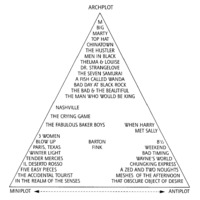-
Title
-
The movie examples mapping in Robert McKee's Story Triangle
-
Description
-
The diagram places movies along a spectrum that spans from Archplot through Miniplot to Antiplot, indicating that few films achieve a pure form that settles at the extreme corners of this triangle. Instead, films tend to blend or borrow from each extreme. Examples given include "The Fabulous Baker Boys" and "The Crying Game," which fall between Archplot and Miniplot. These films combine elements from both structures: they tell the story of a passive main character, and they leave certain plot threads unresolved.
In the case of "When Harry Met Sally," the film initially presents an Archplot romance but later introduces elements of Antiplot, as the interviews with older couples create a documentary style that adds layers of reality and satire.
"Barton Fink" sits at the center of the triangle, drawing qualities from each of the three extremes. It features a single protagonist, a playwright trying to succeed in Hollywood, reflecting the Archplot. However, as Fink becomes more reclusive and suffers from writer's block, elements of Miniplot emerge. The progression into hallucination introduces aspects of Antiplot, with the line between reality and fantasy becoming blurred.
This triangle thus serves as a framework for analyzing the structural choices made in storytelling, emphasizing that writers often navigate the spectrum between the extremes, resulting in a rich diversity of narrative forms.
-
Designer
-
Robert McKee
-
Date
-
1997
-
Bibliographic Citation
-
McKee, Robert. Story: Substance, Structure, Style, ReganBooks, New York, 1997, pp. 45–55.
-
is depiction of attribute
-
English
Triangle
-
has attribute
-
English
Dash Line
-
English
Arrow

